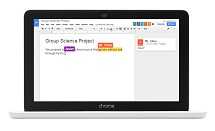A new digital resource offers tips to safely use Google Apps for Education
 A new resource from Gaggle and Amplified IT offers technology facilitators 12 tips to help ensure that Google Apps for Education safe for teachers and students to use.
A new resource from Gaggle and Amplified IT offers technology facilitators 12 tips to help ensure that Google Apps for Education safe for teachers and students to use.
In any implementation, it’s important that school and technology leaders identify benefits and value associated with the implementation.
“Without the right strategies in place, most software and web-based tools–whether free or paid–are under-used in education,” according to the guide.
Next page: 12 tips for Google Apps
Following are the 12 tips, each with a brief description.
For detailed information about any of the tips, interested educators and technology leaders can download the guide for free here, and can take the Google Apps for Education Safety Audit here.
1. Become a student again: When it comes to implementing technology in the classroom, successful teachers endeavor to understand workflow from a student’s point of view.
2. Set milestones for teachers and students: Regardless of which side of the classroom you’re sitting, it’s important to identify where Google Apps for Education can help and focus on those areas first.
3. Remove obstacles: Don’t give yourself, or students, excuses not to use the productivity tools provided for classroom collaboration.
4. Understand safety risks: With Gaggle Safety Management for Google Apps, controls are already set—and regularly updated—to filter text and images.
5. Lead by example: The only way to build new habits is by intentionally and routinely engaging new practices.
6. Provide proper training: Training is extremely important from day one, and it should continue throughout the adoption year and beyond.
7. Integrate Google Apps for Education into your curriculum: As teachers review current curriculum, teaching methods and activities, it will be easy to demonstrate that Google Apps for Education can fit into current teaching practices, making them faster, engaging and more efficient.
8. Prepare a rich template gallery: Don’t reinvent the wheel. There are plenty of public templates popular with educators, including meeting agendas and lesson plans.
9. Ensure lessons meet Common Core and ISTE standards: Common Core and ISTE standards require the use of technology, whether it’s for producing and publishing writing, interacting and collaborating with others, conducting research projects or analyzing arguments.
10. Use Chrome extensions and third-party apps: The Google Apps Marketplace is another invaluable resource.
11. Leverage account provisioning and single sign-on: The end result will be simpler technology integration, which also frees up a school or district IT department, resulting in reduced costs and fewer delays to overburdened school and district technology resources.
12. Track usage: Everyone says they’re using Google Apps, but how do you really know if everyone is using it to its full potential?
- Friday 5: College and career readiness - April 12, 2024
- Cybersecurity: eSN Innovation Roundtable - April 11, 2024
- School-home communication remains a challenge for many districts - April 10, 2024
